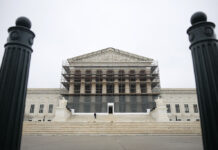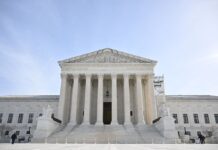The Trump administration on Wednesday asked the Supreme Court to weigh in on the president’s authority to impose tariffs under a 1977 law giving him certain emergency powers. The request came five days after a federal appeals court in Washington struck down the majority of the tariffs imposed by President Donald Trump since February in a series of executive orders. Telling the justices that“[t]he stakes in this case could not be higher,” U.S. Solicitor General D. John Sauer urged the justices to review the ruling by the U.S. Court of Appeals for the Federal Circuit and to do so on an expedited basis, suggesting that the court hear oral arguments in early November.
The tariffs at the center of the case cover many goods from U.S. trading partners. One set of tariffs, known as the “trafficking tariffs,” targets products from Canada, Mexico, and China – which, Trump says, have not done enough to stop the flow of fentanyl into the United States. The second set of tariffs, known as the “reciprocal tariffs,” applies more broadly to impose a minimum tariff of 10% (but up to 50%) on goods from almost all countries.
In imposing the tariffs, Trump relied on the International Emergency Economic Powers Act, a 1977 law that allows the president to take action “to deal with any unusual and extraordinary threat, which has its source in whole or substantial part outside the United States, to the national security, foreign policy, or economy of the United States,” if he declares a national emergency “with respect to such threat.” In particular, section 1702 of IEEPA provides that, when there is a national emergency, the president may “regulate … importation or exportation” of “property in which any foreign country or a national thereof has any interest.”
Two separate challenges to the tariffs – one brought by a group of small businesses and the other by a group of states, led by Oregon – followed in the Court of International Trade. On May 28, the CIT issued a single decision holding that both the trafficking tariffs and the reciprocal tariffs exceeded Trump’s power under IEEPA.
The Trump administration went to the Federal Circuit, which hears appeals from the CIT. The full Federal Circuit heard oral arguments on July 31 and, by a vote of 7-4, upheld the CIT’s ruling on Aug. 29.
In an unsigned opinion, the majority pointed to other laws giving the president the power to impose tariffs. The court of appeals reasoned that when “Congress intends to delegate to the President the authority to impose tariffs, it does so explicitly, either by using unequivocal terms like tariff and duty, or via an overall structure which makes clear that Congress is referring to tariffs.”
The majority continued that reading IEEPA to allow the president to impose virtually any tariffs would also violate the “major questions” doctrine – the idea that when Congress wants to give the executive branch the power to make “decision[s] of vast economic or political significance,” it must say so clearly. The tariffs have such significance, the majority concluded, calling them “transformative.” But in the 48 years since IEEPA was enacted, the majority noted, no other president has invoked it to impose or otherwise regulate tariffs, which suggests that the Trump administration’s interpretation “is incorrect.” This is particularly true, the majority wrote, when “tariffs are a core Congressional power.”
The Federal Circuit sent the case back to the CIT for another look at how broadly its ruling should apply in light of the Supreme Court’s June 27 opinion in Trump v. CASA. That decision generally bars district courts from issuing universal injunctions, which prohibit the government from enforcing a law or policy anywhere in the United States. The court of appeals also put its ruling on hold until at least Oct. 14 to give the Trump administration time to seek Supreme Court review; that deadline is now extended until the Supreme Court proceedings in the case are resolved.
In his 34-page filing, Sauer emphasized that Trump had determined that the “tariffs and the ensuing trade negotiations with all our major trading partners are pulling America back from the precipice of disaster, restoring its respect and standing in the world, eliminating decades of unfair and asymmetric trade policies that have gutted our manufacturing capacity and military readiness, and inducing our trading partners to invest trillions of dollars in the American economy.”
Sauer contended first that the tariffs are authorized by the text of IEEPA. In particular, he argued, “when the broad term ‘regulate’ is paired with ‘importation,’ the term is best read to include the power to impose duties because that is a traditional way to regulate importation.”
The Federal Circuit’s decision is also flawed, Sauer continued, because the majority concluded that IEEPA might permit some tariffs, but not “tariffs of the magnitude” imposed by the president. Such a “textually incoherent holding,” Sauer wrote, “invites judges to gauge the legality of tariffs based on their own policy views of how much is too much, how long is too long, or how many countries are too many. Such judicial second-guessing of the President’s determinations would be improper.”
And the “major questions” doctrine does not bar the president from relying on IEEPA to impose the tariffs, for a variety of reasons, according to Sauer. Among other things, IEEPA “unambiguously authorizes tariffs”; the concerns at the center of the doctrine come into play when agencies, rather than the president, are asserting power; and the Supreme Court has not applied the doctrine “in the national security or foreign policy contexts, because the canon does not reflect ordinary congressional intent in those areas.”
The challengers, Sauer argued, have indicated that they will not oppose Supreme Court review, and they have agreed that the court should fast-track the case. Sauer proposed that the justices act on the Trump administration’s petition for review by Sept. 10 and set oral arguments in the case for the first week of November.
The Supreme Court is already slated to consider a separate challenge to Trump’s tariff authority at its Sept. 29 conference. On May 29, a federal judge in Washington, D.C., barred the Trump administration from enforcing the tariffs against two family-owned toy companies. The toy companies have asked the Supreme Court to review that decision without waiting for the U.S. Court of Appeals for the District of Columbia Circuit to rule on the government’s appeal – a procedure known as “cert before judgment.”
Posted in Featured, Potential Merits Cases
Cases: Learning Resources, Inc. v. Trump
Recommended Citation:
Amy Howe,
Trump administration urges Supreme Court to take up tariffs case,
SCOTUSblog (Sep. 4, 2025, 8:55 AM),
https://www.scotusblog.com/2025/09/trump-administration-urges-supreme-court-to-take-up-tariffs-case/




